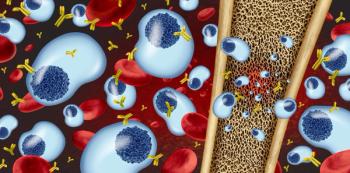One-year treatment with durvalumab (Imfinzi; AstraZeneca) plus standard-of-care Bacillus Calmette-Guerin (BCG) induction and maintenance therapy led to statistically significant and clinically meaningful improvement in disease-free survival (DFS) for patients with high-risk non-muscle-invasive bladder cancer (NMIBC) compared with BCG induction and maintenance therapy alone, according to high-level results from the POTOMAC randomized, open-label, multicenter, global phase 3 trial (NCT03528694).1,2
“These exciting data show that adding 1 year of durvalumab to the current standard treatment significantly extends the time patients live without high-risk disease recurrence or progression,” Maria De Santis, MD, principal investigator in the POTOMAC trial, said in a news release from AstraZeneca. “While most patients with non-muscle invasive bladder cancer are treated with curative intent, 80% see their disease return, and almost half may require life-altering surgery to remove the bladder, underscoring the urgent need to improve treatment."1
According to investigators from AstraZeneca, durvalumab plus BCG induction and maintenance therapy was found to be safe and tolerable among treated patients, with data consistent with the known safety profiles of each individual medicine. Critically, they found that the addition of durvalumab did not hinder patients’ ability to complete BCG induction and maintenance therapy. These data are set to be showcased at an upcoming medical meeting and proliferated with global regulatory authorities, according to the news release.1
“The positive results for [durvalumab] in the POTOMAC trial represent a significant advance that will potentially allow more patients with early-stage bladder cancer to benefit from this important immunotherapy,” Christian Massacesi, chief medical officer and oncology chief development officer at AstraZeneca, said in the news release.1
Data from POTOMAC build on positive developments in NIAGRA, a randomized, open-label, multicenter, phase 3 clinical trial that evaluated durvalumab in patients with MIBC. These patients had to be candidates for radical cystectomy and must not have received prior systemic therapy. Patients treated with durvalumab with chemotherapy followed by adjuvant durvalumab post-surgery had an estimated event-free survival (EFS) of 67.8% at 24 months and demonstrated a statistically significant improvement in EFS and overall survival, according to a pre-specified interim analysis.3
About the Trial
Trial Name: Assessment of Efficacy and Safety of Durvalumab Plus BCG Compared to the Standard Therapy With BCG in Non-muscle Invasive Bladder Cancer (POTOMAC)
ClinicalTrials.gov ID: NCT03528694
Estimated Completion Date: September 30, 2025
These data led to the FDA granting regulatory approval to durvalumab with neoadjuvant chemotherapy followed by single-agent durvalumab for adults with MIBC. Other indications for durvalumab include the curative-intent setting of unresectable, stage 3 non-small cell lung cancer (NSCLC) and as a perioperative treatment in combination with chemotherapy in resectable NSCLC. Durvalumab received its first approval in May 2017 and stands to be further tested as a single agent or in combination with other treatments in the future.1,3
Novel treatments for bladder cancer are particularly necessary, with more than 600,000 cases of the disease diagnosed globally each year. In 2024 alone, around 125,000 patients were treated for high-risk NMIBC, in which a tumor forms in the tissue that lines the inner surface of the bladder. Current standard of care treatment includes transurethral resection of bladder tumor, followed by administering BCG directly into the bladder. However, up to 80% of patients experience disease recurrence within 5 years, with rates of progression up to 45% in high-risk patients.1,4
Durvalumab, a human monoclonal antibody, is designed to bind to the PD-L1 protein to block the interaction of PD-L1 with PD-1 and CD80 proteins. This action helps counter a tumor’s immune-evading tactics and releases the inhibition of immune responses to the cancer. Further research into durvalumab’s tumor-inhibiting mechanism of action stands to continue as more possible indications for the treatment are discovered.1
REFERENCES
1. AstraZeneca. IMFINZI® (durvalumab) regimen demonstrated statistically significant and clinically meaningful improvement in disease-free survival for high-risk non-muscle-invasive bladder cancer in POTOMAC Phase III trial. News Release. Released May 9, 2025. Accessed May 14, 2025. https://www.astrazeneca-us.com/media/press-releases/2025/IMFINZI-durvalumab-regimen-demonstrated-statistically-significant-and-clinically-meaningful-improvement-in-disease-free-survival-for-high-risk-non-muscle-invasive-bladder-cancer-in-POTOMAC-Phase-III-trial.html#
2. ClinicalTrials.gov. Assessment of Efficacy and Safety of Durvalumab Plus BCG Compared to the Standard Therapy With BCG in Non-muscle Invasive Bladder Cancer (POTOMAC). National Library of Medicine. Last Updated May 11, 2025. Accessed May 14, 2025. https://clinicaltrials.gov/study/NCT03528694
3. McGovern G, Halpern L. Durvalumab receives FDA approval for muscle invasive bladder cancer. Pharmacy Times. Published March 28, 2025. Accessed May 14, 2025. https://www.pharmacytimes.com/view/durvalumab-receives-fda-approval-for-muscle-invasive-bladder-cancer
4. American Cancer Society. What Is Bladder Cancer? Last Updated March 12, 2024. Accessed May 14, 2025. https://www.cancer.org/cancer/types/bladder-cancer/about/what-is-bladder-cancer.html





















































































































































































































